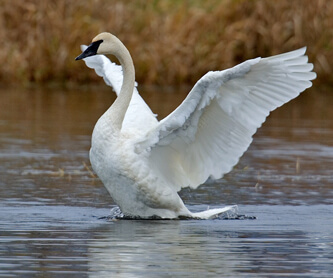Trumpeter Swans Dying from Lead Poisoning in Northwest U.S. and Canada
 |
| Trumpeter Swan. By: Alan Wilson |
(
"We have personally treated at least six cases of fatal lead poisoning in Olympic Peninsula trumpeter swans just this winter, which is likely only a fraction of the number of poisoning cases in the wild," said Matthew Randazzo of the NRWC, a wildlife rescue and rehabilitation organization located in Sequim, Washington on the Olympic Peninsula.
"All of these swans were shown to have ingested lead ammunition, which is poisonous across a wide range of species. If these swans had died in the wild, it's likely that their carcasses would have been consumed by scavengers such as bald eagles, who then could have been poisoned as well,” he said in a recent interview with the Seattle Post Intelligencer newspaper.
The Canadian Wildlife Service also reports that in the Vancouver area, four times as many swans have died from lead poisoning this year, compared to the same time last year. A total of 70 swans — mostly Trumpeter Swans, but also Tundra Swans — died this fall, 32 from lead-shot poisoning in the shared habitat of the Fraser Valley and neighboring Washington State. A total of about 2,500 swans have now died in the region since 1999, mostly from lead shot poisoning.
The use of nontoxic shot for waterfowl hunting has been required in the United States since 1991, and Canada banned the use of lead shot for all migratory bird hunting in 1999. However, spent lead shot continues to remain in the environment where it can be picked up by swans, loons, and other birds who mistake it for grit that they use to grind up food in their gizzards. Additional lead also continues to be introduced to the environment through upland hunting for species such as pheasants and doves.
Last summer, ABC and several other groups petitioned the EPA to ban lead from all ammunition for hunting. The petition presented about 500 studies, most of them peer-reviewed, that documented lead poisoning, but the EPA chose to ignore the evidence and denied the petition.
“Hunters are one of the mainstays of conservation in this country, and many do not realize the impacts of spent lead in poisoning wildlife. We encourage these conservation leaders to lead in getting the lead out to protect their resources, learn more about the problem, and to voluntarily switch over to non-toxic ammunition, which is currently widely available. The price is still higher than lead, but switching to nontoxic will save many Bald and Golden Eagles, mourning doves, swans, and diving birds.” said Dr. Michael Fry, an avian toxicologists and Director of Conservation Advocacy for American Bird Conservancy (ABC), the leading U.S. bird conservation organization.
According to Fry, at least 75 species of birds have been documented with lead poisoning. “The birds slowly succumb to kidney failure, central nervous system malfunction, and gastrointestinal complications. Many of the symptoms, such as seizures and loss of motor control, are similar to those inflicted by pesticides long since banned in the U.S.” he said.
Trumpeter Swans can weigh nearly 40 pounds and live up to 30 years in the wild. Some can grow to six feet in length with a wingspan of nearly ten feet. Most Trumpeters are believed to mate for life and some that lose a mate will not mate again.
Trumpeter Swans were once hunted to the brink of extinction, for game, feathers (used in quill pens and women’s hats), and skin (used to make powder puffs). At the end of the 18th Century, the species was thought to be extinct, but small populations were later discovered in Montana, Wyoming, and Idaho, and another larger population in Alaska. Successful Trumpeter Swan reintroductions in Canada and the United States have increased populations despite significant impacts from lead poisoning, habitat loss, and competition from Mute Swans.


















































